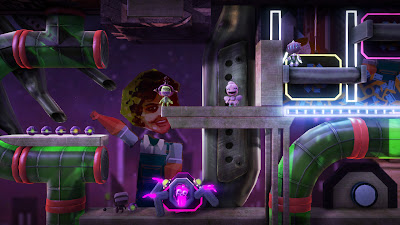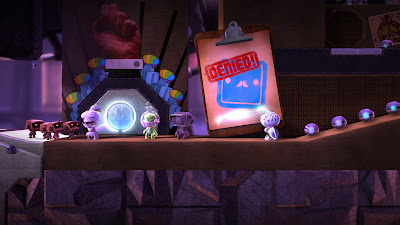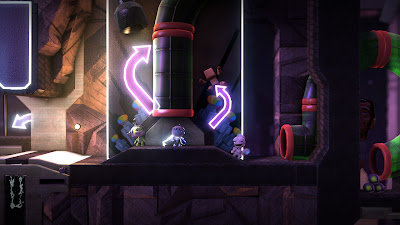Little Big Planet 2 then, appears to be much the same in this regard; the characteristic real-world physics of the title so integral to the very core of the game backed up by some impressive, and downright interesting engine enhancements. This is precisely the reason for us to be taking an extended look at the title. What we have here could almost be described as a full tech analysis of sorts, but in reality it’s more of a small glimpse, and dare I say, intriguing update into what media Molecule are doing with this sequel.
The first thing to notice, obviously, when going over the screenshots is the abundance of clean lines and smooth looking edges, or rather the distinct lack of any jaggies spoiling the scene. Now you might be thinking ‘supersampled’ when seeing the quality of the screens, and initially that’s exactly how I felt about the situation. However, this isn’t actually the case as all the screens you see on this page are direct-feed captures rendering in native 720p (1280x720), and are not downsampled from a higher resolution, as is usually the case with most PR shots released to the press.
The reason for the game’s lack of jagged lines and supersampled look then is clear - the use of morphological anti-aliasing has been implemented into the graphics engine.
Although the above anti-aliasing method has been confirmed by Media Molecule themselves you can still see some evidence of sub-pixel based jagged edges, another hint as to the inclusion of MLAA, as with supersampling this just wouldn't occur

MLAA has been featured a few times before here at IQGamer, namely when covering Santa Monica Studio’s God Of War 3, and more recently Guerrilla Games’ Killzone 3. It feels like not a month goes past without some new first-party title using the technique, a technique which is not only cost saving in terms of memory, but also in terms of securing the highest levels of image quality in a console specific release.
From the screens featured on this page it is apparent that the MLAA does far more for the image than what is possible via the more traditional MSAA, only to be beaten by supersampling (SSAA) which isn’t doable, realistically, on consoles due to the additional rendering performance incurred.
In LBP2, like with GOW3 the use of MLAA provides up to 16x MSAA coverage on some surfaces, and better than 4x on most others. The only area in which this form of AA falls down is when dealing with sub-pixel aliasing, where by any polygon edges smaller than the size of a pixel (this is a sub-pixel) receive absolutely no AA coverage at all. The same is true for MSAA as well, but not for supersampling which covers all aspects of the entire image. Regardless, this new form of anti-aliasing is a huge improvement over the 2xMSAA used in the first game.
Of course, the use of MLAA is just one part of many fundamental changes to the underlying graphics engine. For this sequel the developers have also opted for a solely forward rendering approach throughout the entire game, making transparencies and shadowing much easier to do.

Previously the original LBP used a differed solution to rendering lighting and shadowing in the game, which meant issues with displaying certain effects and also a reduction in shadow quality.
By switching to the traditional forward rendering approach this time around, the developers have been able to easily upgrade the shadowing system used in this sequel. Soft shadows are present throughout, which look much nicer than the hard-edged ones used in LPBP1, with shadows being cast for every main light source you can see, now without the need to pre-calculate them as shadowmaps like before. These soft shadows also blend in well with the game’s newly implemented use of screen-space ambient occlusion (SSAO), which is performed in real-time along with most of the lighting and shadowing.
This use of SSAO also gives an even greater depth to the image not found in the last game, complementing the range of visual enhancements on offer.
Seeing as the computational requirements for producing such graphics effects have probably also gone up, the resolution of these shadows is still relatively low compared to the rest of the game. I’m not sure how much resolution loss is occurring, although it is apparent that all shadows look slightly softer than you’d expect them to be, especially compared to if they were rendering in same resolution to match the rest of the game.
Transparencies however, now look to be rendered in a higher resolution than the first game, using proper alpha coverage, whereas before they were rendered in a half-res of sorts using the bandwidth saving alpha-to-coverage, which lead to a slight screen-door effect being present on all objects that featured it.
The true nature of the translucency is a nice touch, and goes well with other enhancements being made to the whole particle/effects system used through the game.

From what we can see LBP2’s use of soft dynamic shadowing in combination with SSAO is undeniably impressive, providing an incredibly life-like appearance to how the whole scene is lit at any given time. The tightly woven nature of the lighting and how it commands the way shadowing occurs in the game cannot be understated, and to this the addition of a global illumination (GI) style solution adds more believability into the mix.
In LBP2 light on some stages looks like it travels down from a main point (the sun, or a singular internal light source) into the world appearing like it reflects off some objects and onto others as it shades and lights the environment. An impressive visual trick, as in reality it isn’t being done in real-time at all, but instead is a pre-calculated simulation that uses something along the lines of a lightmap, moving these around on certain surfaces to create this effect.
The illusion of proper GI, and some cleverly implemented god rays is the focus here, convincingly backing up the original LBP’s realistic lighting model. Alone, these elements are merely hot discussion points. But when all brought together they bring a real sense of naturalness and cohesion to an abstract game world, much like in the way the use of physics provides us with some tangible connectivity between the game and our own experience of reality.
There's still a disconnect for sure, seeing as the whole style and notion of the game’s world is completely off-the-wall, but in it’s own little confines feels completely organic, succinct even. And that’s perhaps Media Molecule’s biggest success, not the visual wonderment that all these effects and improvements provide, but the ability for them to casually sink in and blend together so seamlessly into being part and parcel of the experience.
Low resolution shadows aside, and maybe some stray un-anti-aliased sub-pixel edges, LBP2’s tech has seen some noticeable changes, and some ingenious solutions to problems most lesser developers tend to flake over. The game isn’t visually outstanding from a ‘wow factor’ point of view, but instead has its moment in delivering small subtleties that do more for the overall experience than just for the sheer technical hell of it.

No comments:
Post a Comment